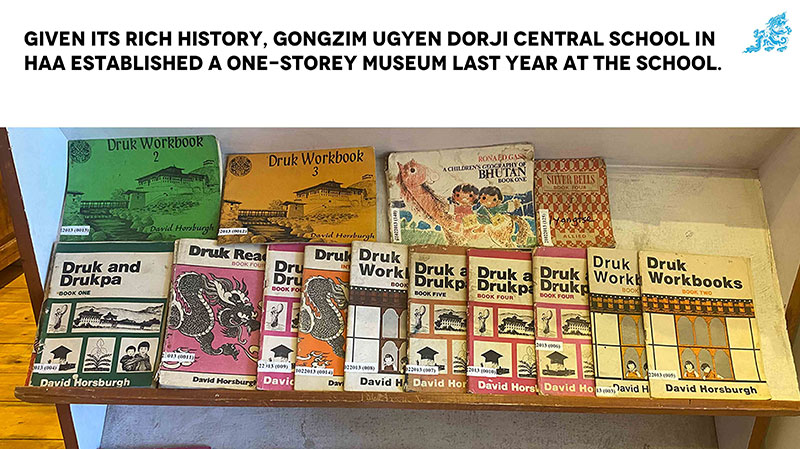Phub Dem | Haa
Where else in Bhutan do you find a school with a museum of its own?
A museum in school sounds anomalous. But that could be because schools normally do not have a museum. Gongzim Ugyen Dorji Central School in Haa saw it in the fitness of things that it could have a museum. And, why not? As the oldest modern school in the country, it has a rich history and many trophies, certificates and artefacts that stand witness to its long and bold journey.
A museum can be defined as an institution that conserves and cares for a collection of artefacts and other objects of artistic, scientific, cultural and historical importance. The word comes from Ancient Greek, mouseion, a place or temple dedicated to the Muses (the patron divinities of the arts in Greek mythology).
Gongzim Ugyen Dorji Central School opened in 1913 as the first modern, English-medium school in the country. Ugyen Dorji, a diplomat par excellence, who served as the chamberlain with the title Gongzim to the First Druk Gyalpo His Majesty King Ugyen Wangchuck, opened the school under the of His Majesty.
The one-storey museum was established last year with the support of dzongkhag administration. The idea of the education museum was conceived during the celebration of the Sherig Century (100 years of education in Bhutan) in 2013.
According to principal, Sonam Chhogyel, the school already had some artefacts essential for historical references. Realizing the urgency of storing the ancient artefacts, he said that the idea of an education museum came up informally. Former Haa Dzongdag Kinzang Dorji played a critical role in the establishment of the museum.
“Had it not been for his wholehearted support, the museum wouldn’t have been possible. The idea may be ours, but the museum as it has come now is his, really,” said Sonam Chhogyel.
The dzongkhag administration collected education artefacts used before 1950, including photographs, for exhibition as a part of the Sherig century celebration.
The museum, among others, contains black and white portraits of its alumni, hurricane lanterns, slates, textbooks, study materials, the oldest school bell and photographs of Haa students with Pandit Jawaharlal Nehru.
Walking down the aisle, one gets a glimpse of how and where learning exactly took place many decades ago. It tells poignant stories of change, of what has disappeared altogether and what has remained through the years.
Tashi teaches History and Geography in the school. He is also the museum’s curator. He said many of the artefacts, books and pictures were donated by alumni. The museum is also a sanctuary for the students, a place to peace and deeper reflection.
“We continue to collect documents and artefacts related to education in the country,” Tashi said.
The museum’s most precious artefact, Tashi, said is the oldest Hindi-English dictionary used in school by Late Lopen Dago.
Sonam Chhogyel said that the school was focused on developing the content and making it accessible to the public. In the future, there will be a full-time staff manning the museum. “Much needs to be done before we decide to open for the public.”
According to Sonam Chogyal, the school was earlier located in Bangena village and was run under the direct supervision of Dasho Gongzim himself.
As time passed, for want of space and growth, the school had to be relocated. In 1954 the school was relocated to Tsina in Katsho gewog, below Wangtsa village. In 1969, it was again moved to the present site, in Lhayulkha village. It was a Junior High School then.
In memory of Dasho Gongzim’s service to the country, His Majesty the Fourth Druk Gyalpo named the school “Ugyen Dorji” in 1995 during the 7th Five-Year Plan meet. “Gongzim” was added to the school’s name on the 21st February 2013 during the celebration of the “Sherig Centenary”.


